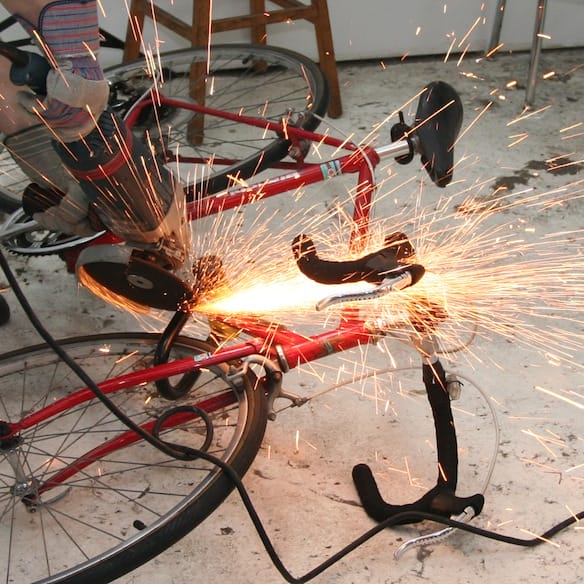
Image credit: Tumblr.
Sanders and Grinders: The Final Touches
The job isn’t done until it’s done. For most home improvement, metalworking, and woodworking jobs, that means that surfaces must be smoothed out and cleaned prior to painting. Burrs need to be ground out of metal openings, and splinters eliminated from anything wood. In the olden days, the final-touch steps of sanding and/or grinding were tedious and time consuming. Even your grandfather can tell you how he used to wrap sandpaper around a block to sand by hand. Nowadays, power sanding and grinding equipment makes the last stages of a job a pleasure. No home or professional shop should be without a sander and grinder.
What Each Can Do
Grinders work mostly, but not exclusively, on metal. Sanders work mostly, but not exclusively, on wood. Grinders tend to be high-torque pieces of equipment that allow you to apply a heavy-duty, rotating grinder edge to whatever it is that needs to be smoothed out or even cut. Different grinding wheels will accomplish different missions. Sanders, on the other hand, tend to be low-torque tools whose job is to take off the very top layer of whatever is being sanded. Different thicknesses of sandpaper attached to the sander can take the sanding all the way from rough to smooth. Sanders can even be used on metal for limited purposes, like paint removal. That said, if the job is more ambitious, use a grinder.
Buying Your Sander
If you’re in the market for a sander, the most important considerations are the jobs where you’ll use it. Your main choice will be between a square-based, orbital finishing sander, and a random orbital sander. Orbital finishing sanders are square, and make the sandpaper vibrate. They use regular sheets of sandpaper in whatever grit you prefer. Powered by batteries, electricity, or even compressed air, they are perfect if most of your work is with veneers and plywood.
More and more, though, do-it-yourselfers and professionals alike are turning to so-called random orbital sanders. Instead of a square sheet of sandpaper under the sander, random orbital sanders utilize a round sandpaper pad that affixes to the sander with either adhesive or Velcro. Since a regular circular pattern is an invitation to gouging the random orbital sanders make the pad move in a random pattern that prevents the grit from gouging. The random orbital sander can handle a wide variety of sandpaper pads. Since the sandpaper spins at upwards of 10,000 revolutions per minute, orbital sanders make short order of most jobs. Within the random orbital sander family are sanders with different grips and power sources. The smallest are palm-grip units. Larger are the pistol-grip sanders, which might need two hands to operate safely and effectively. Power ranges from batteries to electricity to compressed air. A pneumatic palm-grip sander is a potent piece of equipment.
Buying Your Grinder
All grinders are based on the same principle of physics, despite apparent differences in shape and function. There’s a motor, a turning shaft, and a then a grinding wheel that’s applied to whatever you seek to grind down. One choice for you could be a bench grinder that actually bolted workbench, and used for everything from sharpening an awl to blade of a spade. More versatile are the angle grinders and die grinders. Angle grinders have an angled wheel on the end – usually between 4” and 6” – that you can apply to whatever needs to be ground or cut through. A wheel of 4.5” will be sufficient for most jobs. Die grinders, on the other hand, let you attach and change any of a number of specialized grinding tools. For instance, you might use a cone-shaped bit to remove any burrs from a deliberate hold in a pipe, and then change to a wheel, small circular blade, or even a drill bits, depending on the job.
Important Reminders
No matter whether you are sanding or grinding, there are safety considerations. Both operations create toxic dust that you do not want in your eyes and lungs. Therefore, wear eye protection and a filter mask of some kind while you work. Earplugs are good, too. Check equipment thoroughly before using, particularly the condition of grinding wheels. Also, note there are specialized sanders and grinders that might be especially appropriate for your work. For example, big belt-style sanders are very helpful when sanding lumber.



